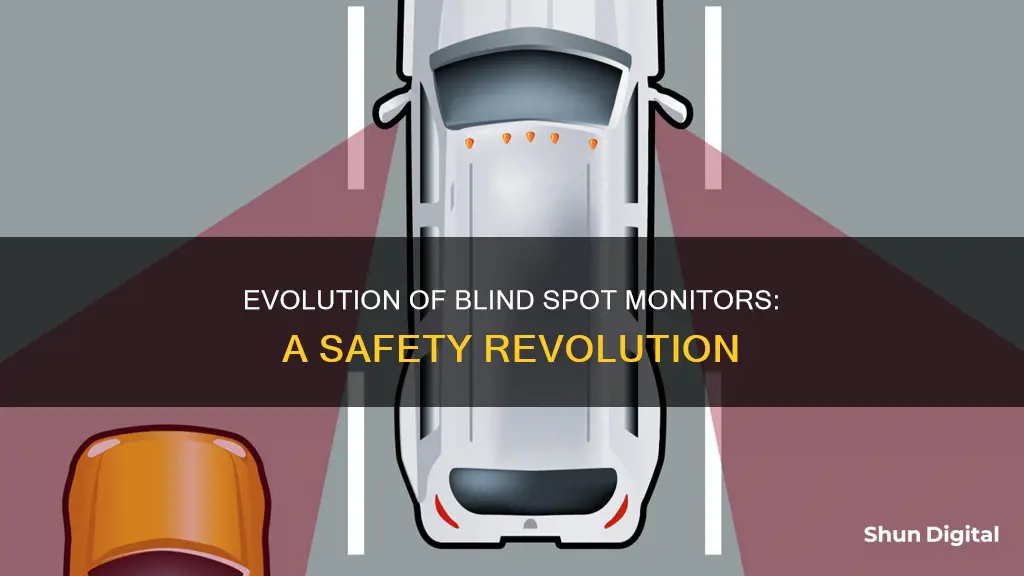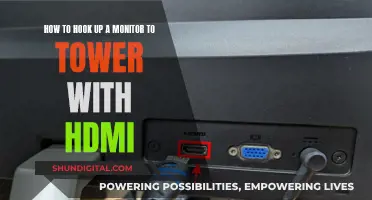
Blind-spot monitoring (BSM) is an advanced driver-assistance system (ADAS) designed to alert the driver to vehicles that may be in their blind spot. A blind spot is an area on either side of a car that a driver cannot see when looking into the rearview or side-view mirrors. Blind spots are why a driver should always turn their head and check for cars before changing lanes. BSM uses radar or ultrasonic sensors located inside the left and right sides of the rear bumpers, as well as cameras in the side-view mirror housings, to detect vehicles within their monitored areas.
Volvo was the first car manufacturer to offer BSM, introducing it on the 2001 Volvo SCC concept car, then placing it into production on the 2003 Volvo XC90 SUV. Mazda was the first Japanese automaker to offer BSM, introducing it on the 2008 Mazda CX-9 Grand Touring.
| Characteristics | Values |
|---|---|
| First introduced | 2001, as a concept in the Volvo SCC concept car |
| First placed into production | 2003, in the Volvo XC90 SUV |
| Alert type | Visual, audible, vibrating, or tactile |
| Alert location | Side-view mirror, A-pillar, driver-information display, or head-up display |
| Alert trigger | Vehicle approaching in an adjacent lane |
| Active gears | Drive and neutral |
What You'll Learn
- The first blind spot monitoring system was introduced in the 2001 Volvo SCC concept car
- Blind spot monitoring systems can be turned on and off
- Blind spot monitoring systems use radar, ultrasonic sensors and cameras
- Blind spot monitoring systems are not a substitute for checking mirrors and looking over your shoulder
- Blind spot monitoring systems can be purchased as an after-market kit

The first blind spot monitoring system was introduced in the 2001 Volvo SCC concept car
Volvo's Blind Spot Information System (BLIS) was the first of its kind, and the company won an AutoCar Safety and Technology award for its introduction. Blind-spot monitoring (BSM) is an advanced driver aid and safety device that can detect what the driver's eyes may miss, issuing a warning as a vehicle approaches in an adjoining lane. This technology is particularly useful because, according to the National Highway Traffic Safety Administration (NHTSA), roughly 9% of all reported vehicle crashes each year result from changing lanes or merging.
BSM systems use radar or ultrasonic sensors located inside the left and right sides of the rear bumpers, as well as cameras in the side-view mirror housings, to detect vehicles within monitored areas. When a passing vehicle approaches and potentially enters a blind spot, the system alerts the driver. This alert usually takes the form of a visual indicator, such as a flashing light in the side-view mirror, but can also be an audible warning, such as a beeping tone, or even a haptic alert such as a vibration through the steering wheel or seat.
While blind-spot monitoring is a useful safety feature, it is not a substitute for checking mirrors and looking over one's shoulder. It is an added safety measure to compensate for human error.
The Ultimate Guide to VESA Mounts for ASUS MX279H Monitors
You may want to see also

Blind spot monitoring systems can be turned on and off
Blind-spot monitoring systems are an active driver aid that can be turned on and off. These systems are designed to detect vehicles in a driver's blind spot, which is the space just off the rear quarter areas of a vehicle that are hidden by the side mirrors. Blind-spot monitoring systems typically use sensors or cameras to detect vehicles in a driver's blind spot and provide a warning, such as a visual, audible, vibrating, or tactile alert.
The ability to turn blind-spot monitoring systems on and off can be useful in certain situations. For example, a driver may want to turn off the system if it is not functioning properly, as indicated by a light on the dashboard, or if they are towing a trailer. In some cases, the system may automatically turn off when the vehicle is in reverse or park gears, as in the case of Ford vehicles.
Blind-spot monitoring systems first started to appear in premium and luxury cars nearly 20 years ago. Today, these systems are available in a range of vehicles, from affordable models to full-size pickup trucks. While not all vehicles come standard with blind-spot monitoring, it is often available as a stand-alone option or in an option package.
For older vehicles that are not equipped with blind-spot monitoring, aftermarket systems can be purchased and installed. These systems typically consist of sensors and indicators that work together to detect hazards and alert the driver. Aftermarket systems can be purchased from various retailers, such as Amazon, Walmart, and Crutchfield, and can range in price from $300 to $500. Professional installation is recommended, but it is also possible to install the system yourself with the help of instructions provided by the manufacturer.
Resetting Your ASUS VG245 Monitor: A Step-by-Step Guide
You may want to see also

Blind spot monitoring systems use radar, ultrasonic sensors and cameras
Blind spot monitoring systems are an active driver aid/safety device that can help prevent accidents by detecting what a driver's eyes may miss. They use radar, ultrasonic sensors and cameras to monitor the sides and rear of a vehicle, warning the driver of any potential dangers.
The least sophisticated examples use radar or ultrasonic sensors embedded in each side of the vehicle’s rear bumper. These sensors detect a vehicle approaching the rear of a car in an adjoining lane. More advanced systems employ side-mounted cameras, which can be used in conjunction with ultrasonic sensors and radar.
The system will warn the driver of a vehicle in their blind spot through visual, audible, vibrating or tactile alerts. Visual alerts are usually a yellow warning light on the wing mirror or the A-pillar (the pillar between the windshield and front door) on the side of the oncoming car. Audible alerts will often sound if a driver indicates to merge into an occupied lane. Some systems will also vibrate the steering wheel or driver's seat.
Blind spot monitoring systems can also be paired with rear cross-traffic alert (RCTA) systems, which use the same sensing tools to monitor the sides of a car at low speeds when reversing.
Blind spot monitoring systems were first introduced by Volvo in 2003, and have since become a common feature in modern vehicles, from premium and luxury cars to more affordable models.
Uncover the True HDR10 Monitor Experience: What to Look For
You may want to see also

Blind spot monitoring systems are not a substitute for checking mirrors and looking over your shoulder
Blind spot monitoring systems are a great addition to your vehicle to help prevent crashes and increase your driving awareness. However, they should not be a substitute for checking mirrors and looking over your shoulder.
Firstly, it is important to note that blind spot monitoring systems are not foolproof. While they can provide valuable assistance, they can also malfunction or fail. Therefore, it is always advisable to manually check your blind spots to ensure your safety.
Secondly, blind spot monitoring systems have limitations. They may not detect pedestrians, cyclists, or pets, putting them at risk. Additionally, they may not detect vehicles travelling at high speeds, as one user reported an incident where a car travelling at over 120 mph was not detected by the system.
Thirdly, blind spot monitoring systems can sometimes be delayed in providing alerts. This delay could potentially lead to accidents if the driver relies solely on the system.
Furthermore, while some advanced systems may provide steering assistance or automatic emergency braking, these features are not standard on all vehicles. It is important to understand the capabilities and limitations of your specific system.
Lastly, blind spot monitoring systems are designed to complement proper mirror usage, not replace it. Properly adjusted mirrors can eliminate blind spots, providing a clear view of the surrounding traffic. This practice, combined with regular shoulder checks, ensures a safer driving experience.
In conclusion, while blind spot monitoring systems offer valuable assistance, they should not replace the fundamental practices of checking mirrors and looking over your shoulder. Staying vigilant and aware of your surroundings is crucial for safe driving.
Asus Monitors: Are There Built-In Microphones?
You may want to see also

Blind spot monitoring systems can be purchased as an after-market kit
Blind-spot monitoring systems (BSM) are vehicle-based sensor devices that detect other vehicles located in a driver's blind spot. These systems can be purchased as an aftermarket kit, ideal for older cars that are not equipped with certain types of technology.
Aftermarket blind spot monitoring systems are available from a variety of retailers, including Amazon, Walmart, and Crutchfield. These kits typically cost between $300 and $500 and can be installed by a professional for an additional $200. The installation process is fairly involved, so it is recommended to have a professional do it unless you have a full day to dedicate to the task.
Aftermarket blind spot monitoring systems typically consist of two main components: sensors and indicators. The sensors are the "eyes" of the system, using technologies such as sonar, radar, and lidar to detect hazards outside the vehicle. Cameras inserted into the side mirrors may also be included to relay information to a computer. The indicators notify the driver of potential hazards through visual and/or audio alerts.
It is important to note that even with a blind spot monitoring system, drivers should continue to use their mirrors and check their blind spots manually. These systems are not a substitute for cautious driving but rather an additional safety feature.
Blind-spot monitoring has evolved since it was first introduced nearly 20 years ago. Initially a novelty reserved for premium and luxury cars, it is now available on a wide range of vehicles, including economy cars and full-size pickup trucks. The benefits of these systems are clear, with the Insurance Institute for Highway Safety (IIHS) reporting that blind-spot monitoring reduces lane-changing accidents by 14% and injuries from lane-changing crashes by 23%.
Enhance Your Viewing Experience: Invest in a New Monitor
You may want to see also
Frequently asked questions
A blind spot monitor is a vehicle-based sensor device that detects other vehicles located to the driver's side and rear. Warnings can be visual, audible, vibrating, or tactile.
Blind spot monitoring was first introduced on the 2001 Volvo SCC concept car, then placed into production on the 2003 Volvo XC90 SUV.
Blind spot monitoring can prevent some accidents and minimise others. It increases driving awareness, makes drivers feel safer and more confident, and gives drivers more time to respond.
Blind spot monitoring is offered by a range of car brands including Honda, Kia, Ford, Lincoln, Mercury, Mazda, Mitsubishi, Nissan, Infiniti, Jeep, and Volvo.







